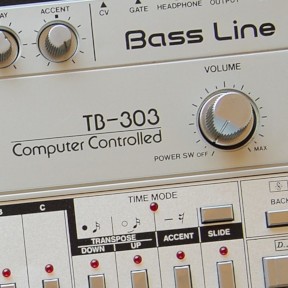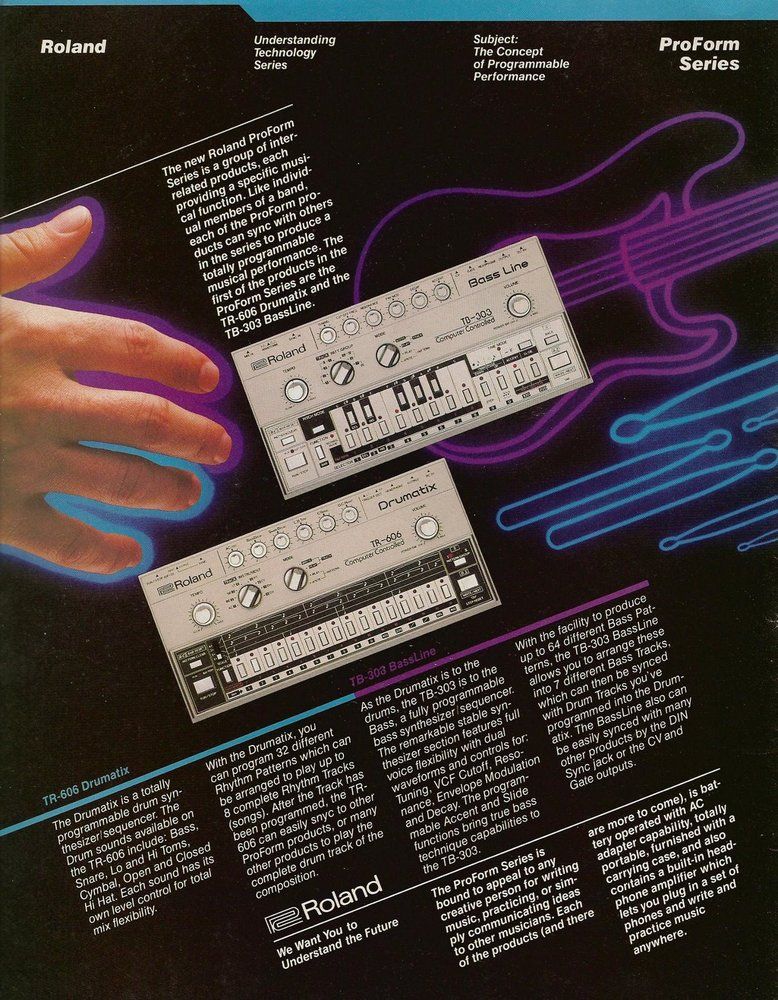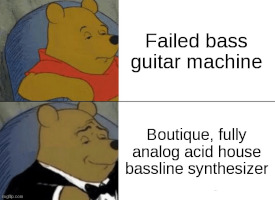303 is a magic number

Few numbers set an electronic musician’s heart aflutter like 303, 808, and 909. I am of course talking about the holy trinity of early eighties synthesizers from Roland: the TB-303, TR-808 and TR-909. Launched in 1981, the TB-303 - “TB” standing for “Transistor Bass” - was marketed alongside the TR-606 Drumatix, a largely forgotten drum machine.
As evidenced by the neon pink outline of a bass guitar in the background of this original advert, the 808 was intended to replicate the sound of a bass guitar.
(Also, images like this have a lot to answer for when it comes to the over-use of glowing pinks and blues typical of the synthwave aesthetic. Yes, I am aware of my choice of colours in the site’s top & bottom banners.)
I challenge anyone to listen to the squelchy, bouncy, distorted goodness going on in classics like Da Funk, Claustrophobic Sting, or Higher State of Consciousness and find any resemblance whatsoever to a bass guitar.
It was a critical and commercial failure, discontinued - according to Roland themselves - less than two years later, and seemed destined to be little more than a boxy grey historical footnote.
Then in Chicago in 1985, a little group called Phuture got their hands on one, and the rest, as they say, is history.

Today, the number 303 itself is synonymous with the very concept of sequenced, repetitive, monophonic, distorted basslines, with trademark ear-splitting resonant squeaks and knob-twiddling filter sweeps. Similarly, the number 808 is synonymous with the deep, boomy, punchy, artificial kick drums so beloved of house, techno, rap, and hip-hop.

But what does the fabled machine actually do? Well… by today’s standards, surprisingly little. For starters, it’s monophonic, meaning it can only play one note at a time. Its one oscillator is limited to two waveforms, square and ramp (a weird kind of backwards sawtooth), which if these graphs are to be believed, are not even remotely close to their visual representations on the case. It doesn’t appear to have any controls for the amplifier envelope: both the decay and “env mod” knobs control the filter envelope, not the amp. It also predates MIDI - apparently coming out in the same year the standard was introduced, albeit earlier - so although it does have a sync port which could at least be used to start & stop it in tandem with other gear, its only means of actually generating notes is via its onboard sequencer.
And therein, I posit, lies the real magic.
Limitations breed creativity
I don’t own a TB-303, but if I’m interpreting what I’ve read elsewhere correctly, you were limited to sequences of up to 16 steps (12 in 3/4 time). Apparently you can have up to 64 such sequences in one “track”, and store up to seven such tracks, but seriously, who does this? Almost nobody, apparently; since every “authentic” 303 track I can think of just loops the same 16 step sequence again and again, twiddling the filter knobs (and, occasionally, the knobs on other FX units processing the signal) as it goes.
But two things make those 16 little steps really shine: accent and slide.
The second of these, slide, ties two or more steps together into a single legato note, with brief pitch-bends in between. But it is the first, accent, which really gives the machine its character: it raises the volume of the note a little, and modulates the filter envelope, briefly increasing both cut-off and resonance above their front panel settings, creating that distinctive squelchy “wow” we all know and love. Being analogue, this effect is created using discrete electronic components, which leads to all sorts of idiosyncracies in real-world use, such as opening the filter even further when playing multiple accented notes in quick succession.
It is these limitations, and the immense scope for happy little accidents, that give the machine its character.
Thinking inside the box
If you want the authentic sound, you’ll have to either buy the real thing, or settle for one of the many, many clones, (digital) re-issues, or software emulations. But if you just want something close enough in vibe to be recognisable, with similar functionality, any number of softsynths with suitable parameter modulation controls can do the trick.
I’ve cobbled something together using Minimonsta, a well-regarded Moog Model D emulation, that builds on the original by adding tons of LFOs and modulation options for every parameter on the panel, including filter cut-off and resonance. All you really need to do:
- Load up a suitable starting patch, like the “BassofAcid” factory preset
- Set the VCA attack & decay by ear, based on your desired tempo, to get the desired amount of “bounce” in each single-note step
- Set VCA sustain down to 0, so that quick single notes cut off naturally before the next step without having to explicitly enter MIDI note off (which always seems to impact the filter envelope - I couldn’t find a way to control filter envelope “release”)
- Add some velocity-controlled modulation to the filter cut-off and resonance controls, ramping up quickly then decaying slightly more slowly, tweaking things until you get a nice pleasing 303 “wow” when hitting the keys at full velocity
- Now for non-accented notes, enter MIDI notes at minimum velocity; then for accents, enter full velocity
- Run it through a compressor to even out the volume a little, as even without any other parameters set to be modulated by velocity, it seems Minimonsta has a certain amount of hard-coded volume control linked to velocity
- For slides, automate turning VCA sustain up to 10 on the first note of a slide, and back down to 0 on the last, for legato playback. Similarly, automate turning glide mode on for the second & subsequent notes, and back off for the first note after the slide.
There’s a bit of popping/clicking at the start of some notes that I haven’t yet figured out the cause of. Seems to just be something Minimonsta does with this patch, regardless of the VCA attack; I’ll probably end up seeing if I can just filter it out.
I’m working on a little track using this technique, as a brief side-side-project to get my creative juices flowing again, following illness and the start of a new year. Then I’ll get back to working on Ataraxy - at least, until I unbox the modular VCO kit sat invitingly in its box on the kitchen table…